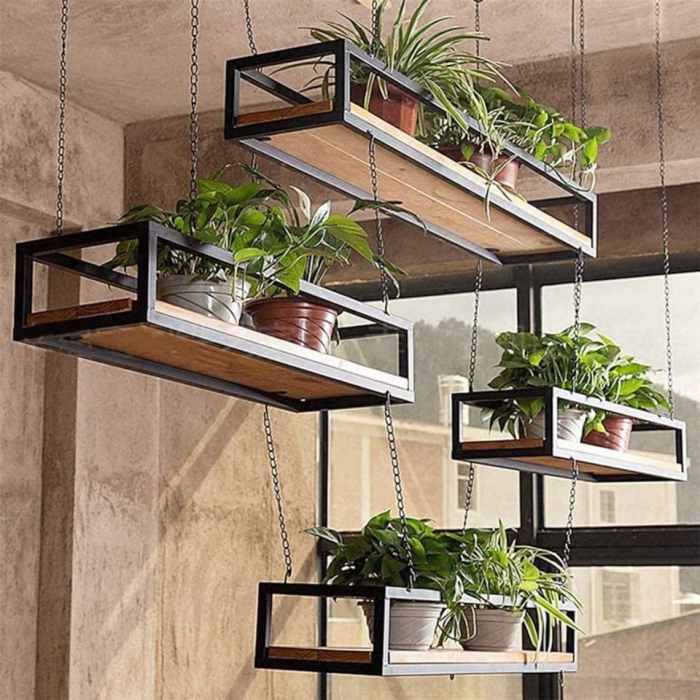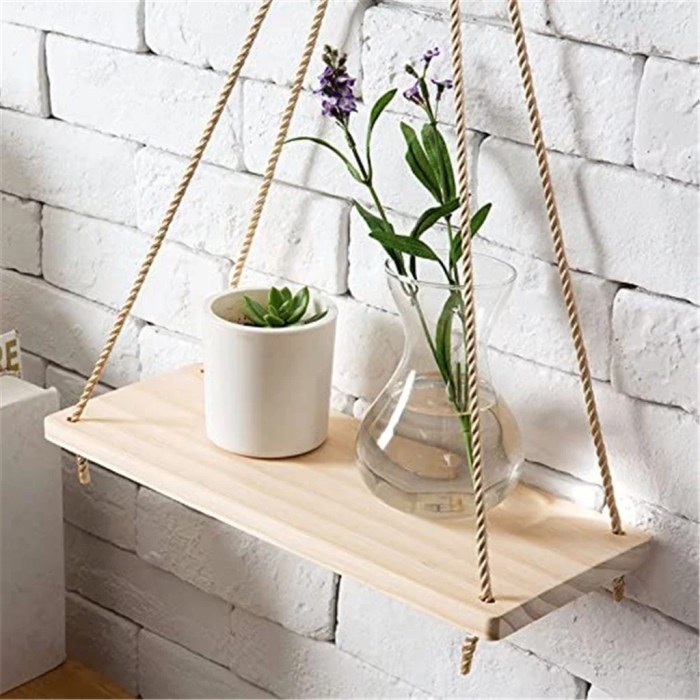Hanging shelf plants are a beautiful and practical way to add greenery and style to your home. They can improve air quality, enhance aesthetics, and optimize space. Whether you’re a seasoned plant parent or just starting out, this guide will provide you with everything you need to know about hanging shelf plants.
From popular plant choices to DIY hanging shelf projects, this comprehensive guide covers all aspects of incorporating hanging shelf plants into your home decor. You’ll also find expert care tips and inspiring display ideas to help you create a thriving and visually stunning indoor oasis.
Popular Hanging Shelf Plants

Hanging shelf plants add a touch of greenery and life to any room, and they can also help to purify the air. Here are some of the most popular hanging shelf plants, along with their botanical names and care levels:
List of Popular Hanging Shelf Plants
| Plant Name | Botanical Name | Care Level | Key Features |
|---|---|---|---|
| Spider Plant | Chlorophytum comosum | Easy | Long, trailing leaves with variegated patterns; produces plantlets |
| Pothos | Epipremnum aureum | Easy | Heart-shaped leaves with various colors and patterns; tolerates low light |
| Snake Plant | Sansevieria trifasciata | Easy | Upright, sword-like leaves with vertical stripes; tolerates neglect |
| ZZ Plant | Zamioculcas zamiifolia | Very Easy | Shiny, oval leaves; tolerates drought and low light |
These plants are all relatively easy to care for, making them a good choice for beginners. They also have a variety of aesthetic appeal, so you can find one that fits your style.
Hanging shelf plants bring a touch of greenery and freshness to any room. If you’re looking to add some extra flair to your indoor plants, consider using basket planters . These stylish and functional planters are perfect for hanging shelf plants, adding a unique touch to your home decor.
From macrame to rattan, there are a variety of basket planters available to complement any style. So, whether you’re a seasoned plant enthusiast or just starting out, hanging shelf plants with basket planters is a great way to elevate your indoor greenery.
Benefits of Hanging Shelf Plants
Incorporating hanging shelf plants into home decor offers a myriad of benefits, contributing to a more inviting and stylish living space. From improved air quality to enhanced aesthetics, these plants provide practical and decorative advantages.
Improved Air Quality
Hanging shelf plants act as natural air purifiers, removing harmful toxins and pollutants from the air. Studies have shown that certain plant species, such as spider plants and peace lilies, are particularly effective at absorbing volatile organic compounds (VOCs) emitted by household products and building materials.
Enhanced Aesthetics
Hanging shelf plants add a touch of greenery and vibrancy to any room. Their lush foliage and delicate blooms create a calming and inviting atmosphere. By placing plants at different heights on shelves, you can create a dynamic and visually appealing display.
Space Optimization
Hanging shelf plants are a great way to maximize space in small apartments or homes. By suspending them from shelves, you can free up valuable floor space while still enjoying the benefits of greenery. They are especially useful in areas with limited window light, as they can be placed closer to the ceiling to receive adequate sunlight.
Examples of how hanging shelf plants can be used to create a welcoming and stylish living space include:
- Suspending a trailing plant, such as an ivy or pothos, from a shelf above a seating area to create a lush and inviting ambiance.
- Placing a small succulent or cactus on a shelf in a home office to add a touch of greenery and brighten up the workspace.
- Using hanging planters to display colorful flowering plants, such as begonias or orchids, on a shelf in a living room to add a pop of color and cheer.
DIY Hanging Shelf Projects
Crafting your own hanging shelves for plants adds a personal touch to your home decor while providing ample space for your greenery. With a few simple materials and some basic tools, you can create functional and stylish shelves that will elevate the aesthetics of any room.
Materials List
- Wooden boards (size and thickness depend on desired shelf size)
- Chain or rope for hanging
- Screws or nails
- Drill or screwdriver
- Measuring tape or ruler
- Pencil or marker
Step-by-Step Instructions
- Cut the wooden boards:Measure and cut the wooden boards to the desired length and width of your shelves.
- Drill holes for hanging:Determine the desired height of the shelves and mark the drilling points on the boards. Use a drill to create holes at these points.
- Attach the chain or rope:Cut the chain or rope to the desired length and thread it through the holes. Secure the chain or rope with knots or crimps.
- Assemble the shelves:Place the wooden boards on the chain or rope, ensuring they are level and evenly spaced. Secure the boards with screws or nails.
- Hang the shelves:Locate suitable hooks or brackets on the ceiling or wall and hang the shelves from the chain or rope.
Plant Care Tips for Hanging Shelves

Hanging shelf plants add a touch of greenery and life to any room, but they require specific care to thrive. Understanding their unique needs, such as watering frequency, light requirements, and fertilization, is crucial for maintaining their health and beauty.
Watering Frequency
Hanging shelf plants generally need less water than their ground-dwelling counterparts due to reduced evaporation. Overwatering can lead to root rot, so it’s important to allow the soil to dry out slightly between waterings. The frequency will vary depending on the plant species, pot size, and environmental conditions.
As a general rule, water when the top inch or two of soil feels dry to the touch.
Light Requirements
The light requirements of hanging shelf plants vary depending on the species. Some plants, such as ferns and peace lilies, prefer indirect light, while others, like succulents and cacti, need bright, direct light. Pay attention to the specific needs of each plant and position it accordingly.
If natural light is insufficient, consider using grow lights to supplement.
Fertilization Needs, Hanging shelf plants
Hanging shelf plants benefit from regular fertilization during the growing season. Use a balanced liquid fertilizer diluted to half strength and apply it according to the manufacturer’s instructions. Avoid over-fertilizing, as this can burn the roots and damage the plant.
Troubleshooting Common Problems
Yellowing leaves:This can indicate overwatering, nutrient deficiency, or insufficient light. Check the watering schedule, fertilize regularly, and adjust the plant’s position to provide more or less light as needed.
Hanging shelf plants add a touch of greenery and life to any room. For those who prefer the look of trailing plants without the maintenance, trailing plants indoor artificial offer a realistic and convenient alternative. These artificial plants can be easily incorporated into existing hanging shelf plant arrangements, providing a lush and vibrant display that will last for years to come.
Stunted growth:This can be caused by insufficient light, nutrient deficiency, or rootbound plants. Ensure the plant is receiving adequate light, fertilize regularly, and consider repotting if the roots have outgrown the pot.
Inspiring Hanging Shelf Plant Displays: Hanging Shelf Plants
Hanging shelf plants have gained popularity for their aesthetic appeal and space-saving benefits. They add a touch of nature and greenery to any room, creating a refreshing and inviting ambiance. To inspire your next hanging shelf plant display, here’s a gallery of visually stunning arrangements:
Creative Arrangements
Experiment with different plant arrangements to create unique and eye-catching displays. Consider grouping plants with contrasting foliage textures and colors, such as trailing vines with upright succulents or bushy ferns with delicate maidenhair ferns. Mix and match plant sizes and shapes to add visual interest and depth to your arrangement.
Different Plant Combinations
The possibilities are endless when it comes to plant combinations. Choose plants with complementary growth habits, such as trailing plants like pothos or ivy with upright plants like snake plants or ZZ plants. Consider plants with different water and light requirements to create a balanced and sustainable display.
Unique Shelf Designs
In addition to traditional wooden or metal shelves, explore unique shelf designs to elevate your plant display. Consider hanging shelves made from reclaimed wood, macrame, or even upcycled items like old ladders or crates. These unconventional shelves add character and personality to your plant arrangement.
Hanging shelf plants add a touch of greenery and freshness to any room. If you’re looking for a more functional way to incorporate plants into your indoor space, consider creating a wall hanging herb garden indoor . This is a great way to grow your own herbs and have them readily available for cooking.
Wall hanging herb gardens are also a great way to save space, as they can be hung on a wall or fence. You can also use hanging shelf plants to create a vertical garden, which is a great way to maximize space and add a touch of greenery to your home.
Last Recap

Hanging shelf plants are a versatile and rewarding addition to any home. They offer a range of benefits, from improved air quality to enhanced aesthetics. By following the tips and advice provided in this guide, you can create a beautiful and thriving hanging shelf plant display that will bring joy to your home for years to come.
Top FAQs
What are the most popular hanging shelf plants?
Some of the most popular hanging shelf plants include pothos, spider plants, philodendrons, and ferns.
What are the benefits of hanging shelf plants?
Hanging shelf plants offer a range of benefits, including improved air quality, enhanced aesthetics, and space optimization.
How do I care for hanging shelf plants?
Hanging shelf plants have specific care requirements, including watering frequency, light requirements, and fertilization needs. Refer to the care tips provided in this guide for detailed instructions.